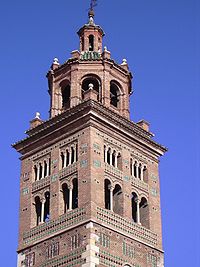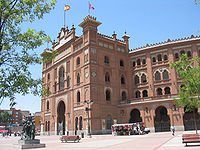Mudéjar
From Wikipedia, the free encyclopedia


Mudéjar is the name given to individual Moors or Muslims of Al-Andalus who remained in Christian territory after the Reconquista but were not converted to Christianity. It also denotes a style of Iberian architecture and decoration, particularly of Aragon and Castile, of the 12th to 16th centuries, strongly influenced by Moorish taste and workmanship.
The word Mudéjar is a Medieval Spanish corruption of the Arabic word Mudajjan مدجن, meaning "domesticated", in a reference to the Muslims who submitted to the rule of the Christian kings.
After the fall of Granada in January of 1492, Mudéjars kept their independent religious status for some time. However, in the mid-16th century, they were forced to convert to Christianity. From that time, because of suspicions that they were not truly converted, they were known as Moriscos. In 1610 those who refused to convert to Christianity were expelled. The distinctive Mudéjar style is still evident in regional architecture, as well as in the music, art, and crafts.
Contents |
[edit] Mudéjar style
In erecting Romanesque, Gothic, and Renaissance buildings, builders used elements of Islamic art and often achieved striking results. Its influence survived into the 17th century.
The Mudéjar style, a symbiosis of techniques and ways of understanding architecture resulting from Muslim and Christian cultures living side by side, emerged as an architectural style in the 12th century on the Iberian peninsula. It is characterised by the use of brick as the main material. Mudéjar did not involve the creation of new shapes or structures (unlike Gothic or Romanesque), but the reinterpretation of Western cultural styles through Islamic influences.
The dominant geometrical character, distinctly Islamic, emerged conspicuously in the accessory crafts using less expensive materials: elaborate tilework, brickwork, wood carving, plaster carving, and ornamental metals. To enliven the planar surfaces of wall and floor, Mudéjar style developed complicated tiling patterns that have never been surpassed in sophistication. Even after Muslims were no longer employed in architecture, many of the elements they had introduced continued to be incorporated into Spanish architecture, thereby giving it a distinctive appearance. The term Mudejar style was first coined in 1859 by José Amador de los Ríos, an Andalusian historian and archeologist.
Historians agree that the Mudéjar style developed in Sahagún, León [1], as an adaptation of architectural and ornamental motifs (especially through decoration with plasterwork and brick). Mudéjar extended to the rest of the Kingdom of León, Toledo, Ávila, Segovia, etc., giving rise to what has been called brick Romanesque style. Centers of Mudéjar art are found in other cities, such as Toro, Cuéllar, Arévalo and Madrigal de las Altas Torres.
It became most highly developed mainly in Aragon, especially in Teruel (although also in Zaragoza, Utebo, Tauste, Daroca, Calatayud, etc.) During the 13th, 14th and 15th centuries, many imposing Mudéjar-style towers were built in the city of Teruel, changing the aspect of the city. This distinction has survived to the present day. Mudéjar led to a fusion between the incipient Gothic style and the Muslim influences that had been integrated with late Romanesque. A particularly fine Mudéjar example is the Casa de Pilatos, built in the early 16th century at Seville.
Seville includes many other examples of Mudéjar style. The Alcázar of Seville is considered one of the greatest surviving examples of the style. The Alcázar expresses Gothic and Renaissance styles, as well as Mudéjar. The Palace originally began as a Moorish fort. Pedro of Castile continued the Islamic architectural style when he had the palace expanded. The parish church of Santa Catalina (pictured) was built in the 14th century over an old mosque.
Portugal also has examples of Mudéjar art and architecture, although the examples are fewer and the style more simple in decoration than in neighbouring Spain. Mudéjar brick architecture is only found in the apse of the Church of Castro de Avelãs [2], near Braganza, similar to the prototypical Church of Sahagún in León. A hybrid gothic-mudéjar style developed also in the Alentejo province in southern Portugal during the 15th-16th centuries, where it overlapped with the manueline style. The windows of the Royal Palace and the Palace of the Counts of Basto in Évora are good examples of this style. Decorative arts of Mudéjar inspiration are also found in the tile patterns of churches and palaces, such as the 16th-century tiles, imported from Seville, that decorate the Royal Palace of Sintra. Mudéjar wooden roofs are found in churches in Sintra, Caminha, Funchal, Lisbon and some other places.
[edit] Neo-Mudéjar architecture
[edit] Gallery
|
Church of San Tirso, Sahagún. |
|||
|
Royal Convent of Santa Clara in Tordesillas, characteristical artesonado ceiling |
Mudéjar castle of La Mota, in Medina del Campo, Valladolid. |
Cathedral of Teruel. |
|
|
Dome of the San Juan church in Calatayud |
Central courtyard of the Royal Palace of Sintra (Portugal), with Mudéjar tiles and arches. |
||
|
Taipa fortifications at Paderne Castle in the Algarve, Portugal |
Wooden mudéjar roof of the chapel of the Royal Palace of Sintra (Portugal) |
Mudéjar tower of the Chapel of the Immaculate Conception in Cali, Colombia |
[edit] See also
| Wikimedia Commons has media related to: Mudéjar |
[edit] References
- Boswell, John (1978). Royal Treasure: Muslim Communities Under the Crown of Aragon in the Fourteenth Century. Yale University Press. ISBN 0300020902
- Harvey, L. P. (1992). "Islamic Spain, 1250 to 1500". Chicago : University of Chicago Press. ISBN 0226319601
- Harvey, L. P. (2005). "Muslims in Spain, 1500 to 1614." Chicago : University of Chicago Press. ISBN 0226319636
- Menocal, Maria Rosa (2002). "Ornament of the World: How Muslims, Jews, and Christians Created a Culture of Tolerance in Medieval Spain". Little, Brown, & Co. ISBN 0316168718
- Rubenstein, Richard (2003). "Aristotle's Children: How Christians, Muslims, and Jews Rediscovered Ancient Wisdom and Illuminated the Middle Ages." Harcourt Books. ISBN 0156030098
















